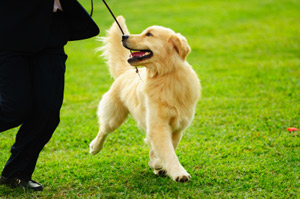Leash Training
Taking a walk can be a fun time for both you and your dog. But if your dog does not know how to walk properly on a leash, it can be a frustrating and tiring event. Teaching your dog to walk nicely on a leash when he/she's a puppy can save you a lot of aggravation both while he/she's young and when he/she's older. This is especially important when you have a big dog. For example being dragged down the street by a 45 kilogram Rottweiler would probably not be considered a very relaxing or fun walk.
The first things you'll need are a leash and a collar. There are many different kinds on the market today, so you'll need to decide which one is most appropriate for your dog. Leashes come in several different materials, including leather, cotton, and nylon. Stay away from leashes made of chain, as they can tear the skin on your hands if your dog makes a quick dash after a cat or a car.
Two meters is a good length for a leash. There are also retractable leashes, which allow your dog from 5 to 8 meters of roaming room. Retractable leashes can be good for walks in the park because they allow your dog a little more freedom, but be mindful of the fact that not everyone likes dogs or wants to be greeted by your dog, so bring him/her back to your side if a person is approaching.

Some leashes come with a built-in collar. If yours does not, a flat nylon or leather buckle collar should do the trick. Some dog owners prefer a harness over a collar. A harness is a good choice if you plan to use some sort of seat belt system in your car instead of confining your dog to a crate. However when you're taking him for a walk, harnesses provide less control than collars. If you do decide on a harness, make sure it's a good fit for your dog, as a harness that's too loose or too tight can rub against his fur and cause sores.
So, now that you have the appropriate accessories, it's time to hit the road! Start with your dog standing next to your left leg. The traditional heel position used by most handlers places the dog on the left side of the owner's body. This is a good place to start and should be maintained until your dog has mastered walking nicely on a leash. However eventually you may not care whether he/she is on your left side, right side, or out in front of you. If he/she is hesitant to stand where you want him/her to, encourage him/her with a tasty treat, and reward him/her when he/sher is in the correct position. Now that he/she is standing at your side, show him/her another treat, and hold it just above his/her nose, at a height where his/her head is up and he can nibble the food without jumping. Say his/her name, and give the command you've chosen for walking, and begin to walk forward. As you walk, watch the leash, and if it begins to tighten, stop walking. Your dog should come to an abrupt stop as well. Stay still, lure him/her back to position with the treat, and resume walking. Over time, he will begin to consistently walk nicely on the leash, and rewarding with treats should no longer be necessary. Teaching a dog to walk nicely on a leash takes time. Be consistent and patient. You'll have a lifetime of long, leisurely walks together to look forward to.